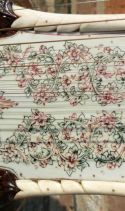 It began with an ordinary crack. Yet another case of overzealous luggage handling at airports. Very regrettable, but in this case it revealed an underlying and overwhelming problem.
It began with an ordinary crack. Yet another case of overzealous luggage handling at airports. Very regrettable, but in this case it revealed an underlying and overwhelming problem. 
A tumba is made out of a gourd, which is a natural product. As it grows on the field, the shape becomes more or less irregular, as squiggly as nature can be. But in a musical instruments setting this isn’t always very usable or good-looking…
Thus here and there some cosmetics are necessary to give it a more practical, handsome round shape. To obtain this, in general, plaster is applied. But sometimes regular plastering isn’t adequate. When more than a couple of millimeters difference in levelling needs to be adjusted a heavier and stronger filler is needed. Then sawdust, wooden dust, water and woodglue are well mixed and applied prior to the plaster mixture.
On this sitar it seems that the mixture has been made with a persistent shortage of glue. And, secondly, really a massive amount of this poorly mixed material has been used. The obvious reason for this is that the original tumba was of a critical quality. Now it is clear that it is just too thin and weak. At several places the tumba is hardly 2mm thick.

Thus, when repairing the crack, more and more chunks of almost already pulverised wooden dust filler simply fell off from the tumba. Finally, almost the complete surface seems to be covered and more than 50% became loose.
In order to obtain a better bonding the plaster is mixed with woodglue as well. A lot of work…, a lot of drying time needed…, sanding, filling, drying, sanding, filling, drying, sanding…, fine sanding, sealing, colouring and finally the finishing touch with shellac.
Read more about tumba repair :
click here




































